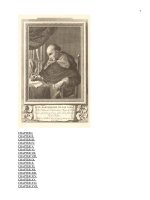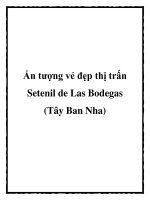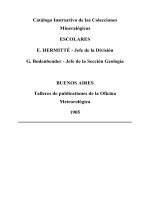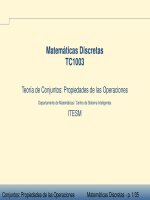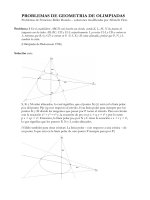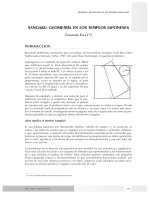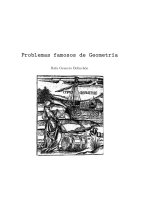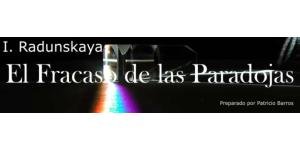problemas de las olimpiadas matemáticas chinas
Bạn đang xem bản rút gọn của tài liệu. Xem và tải ngay bản đầy đủ của tài liệu tại đây (8.93 MB, 273 trang )
Mathematical
Blympiad
in China
Problems
and
Solutions
This page intentionally left blankThis page intentionally left blank
World Scientic
Problems and Solutions
Editors
Xiong Bin
East China Normal University, China
Lee Peng Yee
Nanyang Technological University, Singapore
East China Normal
University Press
Mathematical
Olympiad
in China
Editors
XIONG Bin
East China
~ormal
University, China
LEE Peng Yee
Nanpng
Technological University, Singapore
Original Authors
MO
Chinese National Coaches Team
of
2003
-
2006
English Translators
XIONG
Bin
East China
NO~TTUZ~
University, China
FENG Zhigang
shanghai High School, China
MA
Guoxuan
hst China Normal University, China
LIN Lei
East China
~ormal
University, China
WANG Shanping
East China Normal university, China
ZmNG Zhongyi
High
School
Affiliated to
Fudan
University, China
HA0
Lili
Shanghai
@baa
Senior High
School,
China
WEE Khangping
Nanpng Technological University, singupore
Copy
Editors
NI
Ming
mt China
NO~Z
University
press,
China
ZMG Ji
World Scientific Publishing
GI.
,
Singapore
xu
Jin
hst China
Normal
University
press,
China
V
This page intentionally left blankThis page intentionally left blank
Preface
The first time China sent a team
to
IMO
was in 1985.
At
that time, two
students were sent to take part in the 26th
IMO.
Since 1986, China has
always sent a team of 6 students to
IMO
except in 1998 when it was held in
%wan.
So
far (up to 2006)
,
China has achieved the number one ranking in
team effort for 13 times.
A
great majority of students have received gold
medals. The fact that
China
achieved such encouraging result is
due
to,
on
one hand, Chinese students’ hard working and perseverance, and
on
the other
hand, the effort of teachers in schools and the training offered by national
coaches.
As
we believe, it is also a result of the educational system in
China,
in particular, the emphasis
on
training of basic
skills
in science education.
The materials of this
book
come from a series of four
books
(in
Chinese)
on
Forurzrd
to
IMO:
a
collection
of
mathematical Olympiad
problems
(2003
-
2006). It is a collection of problems and solutions of the
major mathematical competitions in China, which provides a glimpse
on
how the China national team is selected and formed. First, it is the China
Mathematical Competition, a national event, which is held
on
the second
Sunday of October every
year.
Through
the competition, about 120
students are selected to join the China Mathematical Olympiad (commonly
known
as
the Winter Camp)
,
or in short CMO, in January of the second
year. CMO lasts for five days. Both the type and the difficulty of the
problems match those of
IMO.
Similarly, they solve three problems every
day in four and half hours. From CMO, about 20 to 30 students are
selected to form a national training team. The training lasts for two weeks
in March every
year.
After six to eight tests, plus two qualifying
vii
viii
Mathematical Olympiad in China
examinations, six students are finally selected to form the national team, to
take part in
IMO
in July that year.
Because of the differences in education, culture and economy of
West China in comparison with East China, mathematical
competitions in the west did not develop as fast as in the east. In
order to promote the activity of mathematical competition there,
China Mathematical Olympiad Committee conducted the China
Western Mathematical Olympiad from 2001. The top two winners will
be admitted to the national training team. Through the China
Western Mathematical Olympiad, there have been two students who
entered the national team and received Gold Medals at IMO.
Since 1986,
the china team has never had a female student. In
order to encourage more female students to participate in the
mathematical competition, starting from 2002, China Mathematical
Olympiad Committee conducted the China Girls’ mathematical
Olympiad. Again, the top two winners will be admitted directly into
the national training team.
The authors of this book are coaches of the China national team.
They are Xiong Bin, Li Shenghong
,
Chen Yonggao
,
Leng Gangsong,
Wang Jianwei, Li Weigu, Zhu Huawei, Feng Zhigang, Wang
Haiming, Xu Wenbin, Tao Pingshen, and Zheng Chongyi. Those
who took part in the translation work are Xiong Bin, Feng Zhigang,
Ma Guoxuan, Lin Lei, Wang Shanping, Zheng Chongyi, and Hao
Lili. We are grateful to Qiu Zhonghu, Wang Jie, Wu Jianping, and
Pan Chengbiao for their guidance and assistance to authors. We are
grateful to Ni Ming and Xu Jin of East China Normal University
Press. Their effort has helped make our job easier. We are also
grateful to Zhang Ji of World Scientific Publishing for her hard work
leading to the final publication of the book.
Authors
March 2007
Introduction
Early days
The International Mathematical Olympiad (IMO)
,
founded in 1959,
is one of the most competitive and highly intellectual activities in the
world for high school students.
Even before IMO, there were already many countries which had
mathematics competition. They were mainly the countries in Eastern
Europe and in Asia. In addition to the popularization of mathematics
and the convergence in educational systems among different
countries, the success of mathematical competitions at the national
level provided a foundation for the setting-up of IMO. The countries
that asserted great influence are Hungary, the former Soviet Union
and the United States. Here is a brief review of the IMO and
mathematical competition in China.
In 1894, the Department of Education in Hungary passed a
motion and decided to conduct a mathematical competition for the
secondary schools. The well-known scientist,
1.
volt Etovos
,
was the
Minister of Education at that time. His support in the event had made
it a success and thus it was well publicized. In addition, the success of
his
son,
R
.
volt Etovos
,
who was also a physicist
,
in proving the
principle of equivalence of the general theory of relativity by
A.
Einstein
through experiment, had brought Hungary to the world stage
in science. Thereafter, the prize for mathematics competition in
Hungary was named
“Etovos
prize”. This was the first formally
organized mathematical competition in the world. In what follows,
X
Mathematical Olympiad in China
Hungary had indeed produced a lot of well-known scientists including
L.
Fejer,
G.
Szego,
T.
Rado,
A.
Haar
and
M.
Riesz
(in real
analysis),
D.
Konig
(
in combinatorics)
,
T.
von Kdrmdn
(
in
aerodynamics)
,
and
1.
C.
Harsanyi
(in game theory, who had also
won the Nobel Prize for Economics in
1994). They all were the
winners of Hungary mathematical competition. The top scientific
genius of Hungary,
1.
von Neumann,
was one of the leading
mathematicians in the 20th century.
Neumann
was overseas while the
competition took place. Later he did it himself and it took him half
an hour to complete. Another mathematician worth mentioning is the
highly productive number theorist
P.
Erdos.
He was a pupil of
Fejer
and also a winner of the Wolf Prize.
Erdos
was very passionate about
mathematical competition and setting competition questions. His
contribution to discrete mathematics was unique and greatly
significant. The rapid progress and development of discrete
mathematics over the subsequent decades had indirectly influenced the
types of questions set in IMO. An internationally recognized prize
named after Erdos was to honour those who had contributed to the
education of mathematical competition. Professor
Qiu
Zonghu
from
China had won the prize in 1993.
In 1934,
B.
Delone,
a famous mathematician, conducted a
mathematical competition for high school students in Leningrad (now
St. Petersburg). In 1935
,
Moscow also started organizing such event.
Other than being interrupted during the World War
II
,
these events
had been carried
on
until today.
As
for the Russian Mathematical
Competition
(
later renamed as the Soviet Mathematical
Competition)
,
it was not started until 1961. Thus, the former Soviet
Union and Russia became the leading powers of Mathematical
Olympiad.
A
lot of grandmasters in mathematics including
A.
N.
Kolmogorov
were all very enthusiastic about the mathematical
competition. They would personally involve in setting the questions
for the competition. The former Soviet Union even called it the
Mathematical Olympiad, believing that mathematics is the
Introduction
xi
“gymnastics of thinking”. These points of view gave a great impact
on
the educational community. The winner of the Fields Medal in 1998,
M.
Kontsevich,
was once the first runner-up of the Russian
Mathematical Competition.
G
.
Kasparov
,
the international chess
grandmaster, was once the second runner-up.
Grigori Perelman
,
the
winner of the Fields Medal in 2006, who solved the Poincare’s
Conjecture, was a gold medalist of IMO in 1982.
In the United States of America, due to the active promotion by
the renowned mathematician
Birkhoff
and his
son,
together with
G.
Polya
,
the Putnam mathematics competition was organized in 1938
for junior undergraduates. Many of the questions were within the
scope of high school students. The top five contestants of the Putnam
mathematical competition would be entitled to the membership of
Putnam. Many of these were eventually outstanding mathematicians.
There were
R
.
Feynman
(winner of the Nobel Prize for Physics,
1965),
K. Wilson
(winner of the Nobel Prize for Physics, 1982),
1.
Milnor
(winner of the Fields Medal, 1962),
D.
Mumford
(winner of
the Fields Medal, 1974),
D.
Quillen
(winner of the Fields Medal,
1978), et al.
Since 1972, in order to prepare for the IMO, the United States of
American Mathematical Olympiad
(
USAMO) was organized. The
standard of questions posed was very high, parallel to that of the
Winter Camp in China. Prior to this, the United States had organized
American High School Mathematics Examination
(
AHSME)
for the
high school students since 1950. This was at the junior level yet the
most popular mathematics competition in America. Originally, it was
planned to select about 100 contestants from
AHSME
to participate in
USAMO. However, due to the discrepancy in the level of difficulty
between the two competitions and other restrictions, from 1983
onwards, an intermediate level of competition, namely, American
Invitational Mathematics Examination
(
AIME
)
,
was introduced.
Henceforth both
AHSME
and
AIME
became internationally well-
known.
A
few cities in China had participated in the competition and
xii
Mathematical Olympiad in China
the results were encouraging.
The members of the national team who were selected from
USAMO would undergo training at the West Point Military Academy,
and would meet the President at the White House together with their
parents. Similarly as in the former Soviet Union, the Mathematical
Olympiad education was widely recognized in America. The book
“HOW to Solve it” written by
George
Polya
along with many other
titles had been translated into many different languages.
George
Polya
provided a whole series of general heuristics for solving problems of
all kinds. His influence in the educational community in China should
not be underestimated.
International Mathematical Olympiad
In 1956, the East European countries and the Soviet Union took the
initiative to organize the IMO formally. The first International
Mathematical Olympiad (IMO) was held in Brasov, Romania, in
1959. At the time, there were only seven participating countries,
namely
,
Romania
,
Bulgaria, Poland
,
Hungary
,
Czechoslovakia, East
Germany and the Soviet Union. Subsequently, the United States of
America, United Kingdom, France, Germany and also other
countries including those from Asia joined. Today, the IMO had
managed to reach almost all the developed and developing countries.
Except in the year 1980 due to financial difficulties faced by the host
country, Mongolia, there were already
47
Olympiads held and 90
countries participating.
The mathematical topics in the IMO include number theory,
polynomials, functional equations, inequalities, graph theory,
complex numbers, combinatorics, geometry and game theory. These
areas had provided guidance for setting questions for the
competitions. Other than the first few Olympiads, each IMO is
normally held in mid-July every year and the test paper consists of 6
questions in all. The actual competition lasts for
2
days for a total of 9
hours where participants are required to complete
3
questions each
Introduction
xi
day. Each question is
7
marks which total up to 42 marks. The full
score for a team is 252 marks. About half of the participants will be
awarded a medal, where
1/12
will be awarded a gold medal. The
numbers of gold, silver and bronze medals awarded are in the ratio of
1
:2:3 approximately. In the case when a participant provides a better
solution than the official answer, a special award is given.
Each participating country will take turn to host the IMO. The
cost is borne by the host country. China had successfully hosted the
31st IMO in Beijing in 1990. The event had made a great impact
on
the mathematical community in China. According to the rules and
regulations of the IMO, all participating countries are required to
send a delegation consisting of a leader, a deputy leader and
6
contestants. The problems are contributed by the participating
countries and are later selected carefully by the host country for
submission to the international jury set up by the host country.
Eventually, only
6
problems will
be
accepted for use in the
competition. The host country does not provide any question. The
short-listed problems are subsequently translated, if necessary
,
in
English, French, German, Russian and other working languages.
After that
,
the team leaders will translate the problems into their own
languages.
The answer scripts of each participating team will be marked by
the team leader and the deputy leader. The team leader will later
present the scripts of their contestants to the coordinators for
assessment.
If
there is any dispute, the matter will be settled by the
jury. The jury is formed by the various team leaders and an appointed
chairman by the host country. The jury is responsible for deciding the
final
6
problems for the competition. Their duties also include
finalizing the marking standard, ensuring the accuracy of the
translation of the problems, standardizing replies to written queries
raised by participants during the competition, synchronizing
differences in marking between the leaders and the coordinators and
also deciding
on
the cut-off points for the medals depending
on
the
xiv
Mathematical Olympiad in China
contestants’ results as the difficulties of problems each year are
different.
China had participated informally in the
26th
IMO in 1985. Only
two students were sent. Starting from 1986, except in 1998 when the
IMO was held in Taiwan, China had always sent 6 official contestants
to the IMO. Today, the Chinese contestants not only performed
outstandingly in the IMO, but also in the International Physics,
Chemistry, Informatics, and Biology Olympiads.
So
far,
no
other
countries have overtaken China in the number of gold and silver
medals received. This can be regarded as an indication that China
pays great attention to the training of basic skills in mathematics and
science education.
Winners
of
the
IMO
Among all the IMO medalists, there were many of them who
eventually became great mathematicians. Some of them were also
awarded the Fields Medal, Wolf Prize or Nevanlinna Prize
(
a
prominent mathematics prize for computing and informatics). In
what follows, we name some of the winners.
G. Margulis
,
a silver medalist of IMO in 1959
,
was awarded the
Fields Medal in 1978.
L.
Lovasz,
who won the Wolf Prize in 1999,
was awarded the Special Award in IMO consecutively in 1965 and
1966.
V.
Drinfeld
,
a gold medalist of IMO in 1969, was awarded the
Fields Medal in 1990.
1.
-C.
Yoccoz
and
T. Gowers,
who were both
awarded the Fields Medal in 1998, were gold medalists in IMO in 1974
and 1981 respectively. A silver medalist of IMO in 1985,
L.
Lafforgue
,
won the Fields Medal in 2002. A gold medalist of IMO in
1982,
Grigori Perelman
from Russia, was awarded the Fields Medal in
2006 for solving the final step of the Poincar6 conjecture. In 1986,
1987, and 1988,
Terence Tao
won a bronze, silver, and gold medal
respectively. He was the youngest participant to date in the IMO,
first competing at the age of ten. He was also awarded the Fields
Medal in 2006.
Introduction
xv
A silver medalist of IMO in 1977,
P.
Shor,
was awarded the
Nevanlinna Prize. A gold medalist of IMO in 1979,
A.
Razborov
,
was awarded the Nevanlinna Prize. Another gold medalist of IMO in
1986,
S.
Smirnov,
was awarded the Clay Research Award.
V.
Lafforgue,
a gold medalist of IMO in 1990, was awarded the
European Mathematical Society prize. He is
L.
Laforgue’s
younger
brother.
Also,
a famous mathematician in number theory,
N.
Elkis,
who
is also a foundation professor at Havard University, was awarded a
gold medal of IMO in 1981. Other winners include
P.
Kronheimer
awarded a silver medal in 1981 and
R.
Taylor
a contestant of IMO in
1980.
Mathemat ica
I
competitions in China
Due to various reasons
,
mathematical competitions in China started
relatively late but is progressing vigorously.
“We are going to have our own mathematical competition too!”
said
Hua
Luogeng.
Hua
is a house-hold name in China. The first
mathematical competition was held concurrently in Beijing
,
Tianjing,
Shanghai and Wuhan in 1956. Due to the political situation at the
time, this event was interrupted a few times. Until 1962, when the
political environment started to improve, Beijing and other cities
started organizing the competition though not regularly. In the era of
cultural revolution, the whole educational system in China was in
chaos. The mathematical competition came to a complete halt. In
contrast, the mathematical competition in the former Soviet Union
was still on-going during the war and at a time under the difficult
political situation. The competitions in Moscow were interrupted only
3
times between 1942 and 1944. It was indeed commendable.
In 1978, it was the spring of science.
Hua
Luogeng
conducted the
Middle School Mathematical Competition for
8
provinces in China.
The mathematical competition in China was then making a fresh start
and embarked
on
a road of rapid development.
Hua
passed away in
xvi
Mathematical Olympiad in China
1985. In commemorating him, a competition named
Hua
Luogeng
Gold Cup was set up in 1986 for the junior middle school students and
it had a great impact.
The mathematical competitions in China before 1980 can be
considered as the initial period. The problems set were within the
scope of middle school textbooks. After 1980, the competitions were
gradually moving towards the senior middle school level. In 1981
,
the
Chinese Mathematical Society decided to conduct the China
Mathematical Competition, a national event for high schools.
In 1981
,
the United States of America, the host country of IMO,
issued an invitation to China to participate in the event. Only in 1985
,
China sent two contestants to participate informally in the IMO. The
results were not encouraging. In view of this, another activity called
the Winter Camp was conducted after the China Mathematical
Competition. The Winter Camp was later renamed as the China
Mathematical Olympiad or CMO. The winning team would be
awarded the
Chern
Shiing-Shen
Cup. Based
on
the outcome at the
Winter Camp, a selection would be made to form the 6-member
national team for IMO. From 1986 onwards, other than the year
when IMO was organized in Taiwan, China had been sending a 6-
member team to IMO every year. China is normally awarded the
champion or first runner-up except
on
three occasions when the results
were lacking. Up to 2006, China had been awarded the overall team
champion for 13 times.
In 1990, China had successfully hosted the 31st IMO. It showed
that the standard of mathematical competition in China has leveled
that of other leading countries. First, the fact that China achieves the
highest marks at the 31st IMO for the team is an evidence of the
effectiveness of the pyramid approach in selecting the contestants in
China. Secondly, the Chinese mathematicians had simplified and
modified over 100 problems and submitted them to the team leaders of
the 35 countries for their perusal. Eventually, 28 problems were
recommended. At the end, 5 problems were chosen OM0 requires 6
Introduction
xvii
problems). This is another evidence to show that China has achieved
the highest quality in setting problems. Thirdly, the answer scripts of
the participants were marked by the various team leaders and assessed
by the coordinators who were nominated by the host countries. China
had formed a group
50
mathematicians to serve as coordinators who
would ensure the high accuracy and fairness in marking. The marking
process was completed half a day earlier than it was scheduled.
Fourthly, that was the first ever IMO organized in Asia. The
outstanding performance by China had encouraged the other
developing countries, especially those in Asia. The organizing and
coordinating work of the IMO by the host country was also reasonably
good.
In China, the outstanding performance in mathematical
competition is a result of many contributions from all the quarters of
mathematical community. There are the older generation of
mathematicians, middle-aged mathematicians and also the middle and
elementary school teachers. There is one person who deserves a
special mention and he is
Hua Luogeng.
He initiated and promoted
the mathematical competition. He is also the author of the following
books: Beyond
Yang
hui’s
Triangle, Beyond the
pi
of
Zu
Chongzhi
,
Beyond the Magic Computation of
Sun-zi
,
Mathematical Induction,
and Mathematical Problems of Bee Hive. These books were derived
from mathematics competitions. When China resumed mathematical
competition in 1978, he participated in setting problems and giving
critique to solutions of the problems. Other outstanding books derived
from the Chinese mathematics competitions are: Symmetry by
Duan
Xuefu,
Lattice and Area by
He
Sihe,
One Stroke Drawing and
Postman Problem by
Jiang
Boju
.
After 1980
,
the younger mathematicians in China had taken over
from the older generation of mathematicians in running the
mathematical competition. They worked and strived hard to bring the
level of mathematical competition in China to a new height.
Qiu
Zonghu
is one such outstanding representative. From the training of
xviii
Mathematical Olympiad in China
contestants and leading the team 3 times to IMO to the organizing of
the 31th IMO in China, he had contributed prominently and was
awarded the
P.
Erdos
prize.
Preparation for
IMO
Currently, the selection process of participants for IMO in China is as
follows.
First, the China Mathematical Competition, a national
competition for high Schools, is organized
on
the second Sunday in
October every year. The objectives are: to increase the interest of
students in learning mathematics, to promote the development of co-
curricular activities in mathematics, to help improve the teaching of
mathematics in high schools, to discover and cultivate the talents and
also to prepare for the IMO. This happens since 1981. Currently there
are about 200
000 participants taking part.
Through the China Mathematical Competition, around 120 of
students are selected to take part in the China Mathematical Olympiad
or CMO, that is, the Winter Camp. The CMO lasts for
5
days and is
held in January every year. The types and difficulties of the problems
in CMO are very much similar to the IMO. There are also 3 problems
to be completed within four and half hours each day. However, the
score for each problem is
21
marks which add up to 126 marks in
total. Starting from 1990, the Winter Camp instituted the
Chern
Shiing-Shen
Cup for team championship. In 1991, the Winter Camp
was officially renamed as the China Mathematical Olympiad (CMO)
.
It is similar to the highest national mathematical competition in the
former Soviet Union and the United States.
The CMO awards the first, second and third prizes. Among the
participants of CMO, about 20 to 30 students are selected to
participate in the training for IMO. The training takes place in March
every year. After 6 to
8
tests and another
2
rounds of qualifying
examinations, only 6 contestants are short-listed to form the China
IMO national team to take part in the IMO in July.
Introduction
XiX
Besides the China Mathematical Competition (for high schools)
,
the Junior Middle School Mathematical Competition is also developing
well. Starting from 1984, the competition is organized in April every
year by the Popularization Committee of the Chinese Mathematical
Society. The various provinces, cities and autonomous regions would
rotate to host the event. Another mathematical competition for the
junior middle schools is also conducted in April every year by the
Middle School Mathematics Education Society of the Chinese
Educational Society since 1998 till now.
The
Hua
Luogeng
Gold Cup, a competition by invitation, had
also been successfully conducted since 1986. The participating students
comprise elementary six and junior middle one students. The format
of the competition consists of a preliminary round, semifinals in
various provinces, cities and autonomous regions, then the finals.
Mathematical competition in China provides a platform for
students to showcase their talents in mathematics. It encourages
learning of mathematics among students. It helps identify talented
students and to provide them with differentiated learning
opportunity. It develops co-curricular activities in mathematics.
Finally, it brings about changes in the teaching of mathematics.
This page intentionally left blankThis page intentionally left blank
Contents
Preface
lntroduct ion
vii
ix
China Mathematical Competition
1
2002 (Jilin)
2003 (Shaanxi)
2004 (Hainan)
2005 (Jiangxi)
2
13
24
38
China Mathematical Competition (Extra Test)
51
2002 (Jilin)
2003 (Shaanxi)
2004 (Hainan)
2005 (Jiangxi)
51
55
60
67
China Mathematical Olympiad
74
2003 (Changsha, Hunan)
2004 (Macao)
2005 (Zhengzhou, Henan)
2006 (Fuzhou, Fujian)
74
90
99
113
China Girls’ Mathematical Olympiad
126
2002 (Zhuhai, Guangdong)
2003 (Wuhan, Hubei)
2004 (Nanchang
,
Jiangxi)
2005 (Changchun, Jilin)
126
134
142
156
xxii
Mathematical Olympiad in China
China Western Mathematical Olympiad
166
2002
(Lanzhou, Gansu)
2003
(Urumqi, Xinjiang)
2004
(Yinchuan, Ningxia)
2005
(Chengdu, Sichuan)
166
177
185
195
International Mathematical Olympiad
203
2003
(Tokyo, Japan)
2004
(Athens, Greece)
2005
(Mkrida, Mexico)
2006
(Ljubljana, Slovenia)
204
213
232
243
China Mathematical
Competition
The China Mathematical Competition is organiEd in October
every year. The Popularization Committee of the Chinese
Mathematical Society and the local Mathematical Society are
responsible for the assignments of the competition problems.
The test paper consists of
6
choices,
6
blanks and
3
questions to be solved with complete process. The full score is
150
marks. Besides,
3
questions are used in the Extra Test, with
50
marks each. The participants with high total marks in the China
Mathematical Competition plus the Extra Test are awarded the first
prize
(1
000
participants around China), and they will be admitted
into the university directly.
The participants with excellent marks are selected to take part
in the China Mathematical Olympiad the next year. Thus, for
Chinese high school students, the China Mathematical Olympiad
is the first step to
IMO.
2
Mathematical Olympiad in China
2002
(Jilin)
Popularization Committee of CMS and Jilin Mathematical Society
were responsible for the assignment of the competition problems in
the first and second rounds of the contests.
Part
I
Multiple-choice Questions (Questions
1
to
6
carry
6
marks
each.)
@@
The interval
on
which the function
f(x)
=
log+
(2
-
2x
-
3)
is
)
.
monotone increasing is
(
(A)
(Em,
-1)
(€3)
(Em,
1)
(C)
(l,+m)
(D)
(3,
+m>
Solution
First, we will find the domain of
f(x).
From
2
-
2x
-
3
>
0,
we obtain
x
<-
1
or
x
>
3.
So
the domain of definition for
f(x)is( ,
-1)U
(3,+m). Butu=2-2x-3=
(~-1)~-
4
is monotone decreasing
on
(-
00
,
-
1)
,
and monotone increasing
on
(3
,
+
00).
So
fcx)
=
log3
(2
-
2x
-
3)
is monotone increasing
on
(-
00
,
-
1)
,
and monotone decreasing
on (3
,
+
00).
Answer:
A.
If
realnumbersxandysatisfy(~+5)~+(y-12)~=14~, then
the minimum value of
2
+
3
is
(
(A)
2 (B)
1
(C)
43
(D)
./z
).
Solution
Let
x+
5
=
14cosOand
y-
12
=
14sin0,
for
0
E
[0,
2x).
Hence
=142
+
52
+
122
-
140~0s
8+
336sin
0
=365 +28(12sin8- 5~0~8)
China Mathematical Competition
2002
3
=365
+
28
x
13sidO-
9)
=365
+
364sidO-
9)
,
5
where tan9
=
-
12'
3x 5
2 12
So
2
+$
has the minimum value
1,
when
O=
-
+arctan-, i. e.
5 12
13 13
x
=
-
andy
=
Answer:
B.
Remark
A
geometric significance of this problem is:
(x+5I2
+
(y
-
1212
=
142 is a circle with
C(-
5, 12) as center and 14 as radius.
We can find a point
P
on the circumference of this circle such that
I
PO
I
is minimal, where
0
is the origin of the coordinate system.
We join
CO
and extend it to intersect the circumference of the circle
at
P.
Then it follows that
I
PO
I
is the minimum value of
2
+y2.
is
(
>.
@&
The function
f
(x)
=
~
-
-
1-2x 2
X X
(A)
an even but not odd function
(B)
an odd but not even function
(C)
a both even and odd function
(D)
a neither even nor odd function
Solution
It is easy to see that the domain of
f
(x)
is
(-
-,
0)
U
(0,
+-I.
Whenx
E
( ,
0)
U
(0,
+-I,
we have
X X
-
fh>.
-
-
1-2x 2
Therefore,
f(x)
is an even function, and obviously not an odd
